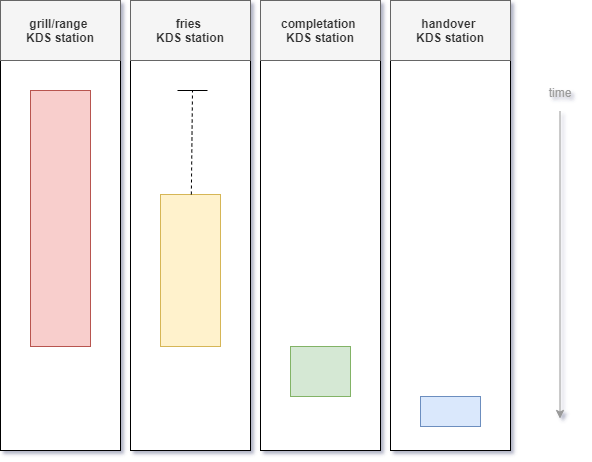A guide to Kitchen Display System (KDS) in restaurant
In a traditional and well-established way of running a restaurant, there is a close communication between the waiter and the cooker. The first one collects orders and the second one needs to find the best way to deliver all orders on time.
Also, the first one needs to answer questions about “why these people have come after us and got their order earlier?” or similar ones. But this approach works only when there is a manageable stream of customers and a good communication between the servicing room and the kitchen.
If there are dense streams of customers seen in fast food restaurants, where the cashier has to process order-by-order and reply as fast as possible, running the restaurant in the non-fast-food paradigm becomes impossible. But not only – in any larger restaurant including the Michellin-starred ones, a waiter needs to collect the order and transfer it to the kitchen as fast as possible.
And that’s where the Kitchen Display System comes into play.

What is kitchen display system
In its basic form, a KDS is a system that connects the ordering point (POS, Ordering app, Self-ordering KIOSK), and the kitchen, where the orders are displayed and the information is exchanged. This definition clarifies little to nothing, so it is necessary to process it step-by-step.
- The system connects the ordering point with the kitchen – in a modern restaurant there are at least a few points where the customer can order the meal. It can be done with the cashier (POS), through the ordering kiosk, via mobile app or online, through the online ordering system or integration service.
- The orders are displayed – the KDS usually takes a form of a digital display showing a queue of orders to prepare. In a more sophisticated version, the system can manage the queue to deliver the meals in the most effective way.
- The information is exchanged – the KDS system is also a tool to facilitate the communication between the cooking team, cashiers, waiters and customers. Each team can communicate with the rest and inform about the status of the order, the estimated time of arrival or an expected delay.
- The information is preprocessed – the most sophisticated systems not only send the information between the kitchen and the serving room, but also queue it and preprocess. For example if there is an order for a burger, fries and salad, there are three elements to be collected – a burger needs to be grilled, fries fried and salad dressed with sauces. Everything needs to be served as fast as possible and fresh. The system can take care of that by displaying an order in a queue, for example fries with a five minute delay, to ensure the highest quality of the order.
Considering all features above, a properly used Kitchen Display System is a central pivot of the workflow in the restaurant. Also, when connected with display systems available for customers it can significantly reduce the frustration and improve the customer experience.
According to Arise data, two-thirds of people consider two minutes of waiting the longest time they accept. For 17% of people surveyed, there was “no time acceptable” to wait. With a few tricks, a kitchen display system can tackle this challenge easily.
Kitchen Display System Benefits
Assuming only a basic set of features in the KDS, the system appears to be unsophisticated and sturdy to a degree. This can be a truth for the most basic form of it. But the more advanced forms deliver many advantages
No lost orders
The main benefit of the KDS is keeping all orders in a single and centralized stream that flows from the ordering point to the kitchen. Thus, the frustrating and embarrassing situation of losing an order and making the customer wait for long only to inform him or her that there will be no meal, will never take place.
Dish preparation queuing
With a KDS operating in the restaurant, the cooking team get the clear view of meals to prepare and time of their order. Thus, the team can manage its work to stick to the meals as best as possible. The order can be further processed using multiple approaches with splitting by a specialist and the cooking device being the best example.
Workflow management
The other side of the same coin – with the clear view of the queue the team gets a clear view of the work to do. Thus, it is easier to avoid mismanagement and overworking. The team can manage its time in a more rational and efficent way.
The order processing team and the cooking team can communicate in a more smooth way, so any miscommunication is reduced to a minimum. Also, with the assistance of a digital system, any miscommunication is less probable to take place.
As mentioned above, there are multiple benefits of the system assuming it is a more sophisticated one. Considering that, there are at least several features to include.
Kitchen Display System features
The sophistication of the system is a key element distinguishing the good and bad KDS system. So what are the most important features of a system of this type?
Automated cooking time management
It is not necessary to prepare meals in the direct order of their arrival. To make the best use of the owned resources, the cooking team can start frying or cooking a particular meal earlier due to its longer preparation time. A sophisticated system can automate the flow management and maximize the usage of the kitchen devices.
Workflow processing
Following the recipe is one of key aspects of success. This principle is behind an enormous success of consumer market-aimed cooking devices that provide the user with clear instructions of what and when to do and how.
A modern KDS system serves the same purpose, but for the whole cooking team. In the ideal situation the system manages not only a flow of orders, but also a workflow of a whole team, ensuring that all meals are delivered on time, fresh and without wasting time.

Routing
The same goes for using the kitchen devices – there is a limited number of fryers, ovens or other devices that are vital for the cooking workflow. When having access to the incoming stream of orders and the occupation of each device, the system can route the orders to make the system as efficient as possible.
When thinking about a big, crowded restaurant, routing can be a challenging task that may be weary for a human mind. But the machine can find unexpected optimizations and data-driven insights to leverage and deliver better results.
Source of management information
KDS can also be a vital source of data that can help optimize running the whole restaurant. Not only is it possible to see throughput of each kitchen station and worker performance, general kitchen throughput can be used to adjust ordering platform promised delivery time and even to limit orders from some channels (especially with lower margin).
Integrability
A sophisticated KDS system like OrderingStack is a cloud-based software that can be a huge productivity-booster for a restaurant of any type. But also, the KDS can be used as a component of a larger system. Thus, implementing a modern KDS means not a total technological revolution in restaurants – OrderingStack can be integrated as a KDS SaaS module with any POS system existing as well as with warehouse management systems, ordering channels, accounting and various other digital tools.
Summary
The Kitchen Display System is a core of any modern restaurant and a key to the further digital transformation. Without it, applying next systems would be a tremendous risk of lost orders and productivity consumed by chaos.
If you wish to discuss the issue or have questions regarding the modern Kitchen Display System (KDS) don’t hesitate to contact us now!
Example kitchen workflows supported by KDS
Simple workflow (one KDS)
- order is entered (via POS, Online Ordering Channel, aggregator or KIOSK)
- task on KDS appears
- kitchen worker marks task when starts working on it
- kitchen worker marks task as done
- kitchen worker marks task as delivered
More advanced workflow in BURGER restaurant (4 KDS and 4 kitchen stations)
- order is entered (via POS, Online Ordering Channel, aggregator or KIOSK)
- GRILL STATION: task with burgers items appears
- GRILL STATION: worker marks when start to prepare it 4 minutes later
- FRIES STATION: task with fries appears (4 minutes after GRILL > STATION started)
- COMPLETION STATION: task with all items appears
- COMPLETION STATION: see when items on GRILL and FRIES STATION is > done
- COMPLETION STATION: gets all order parts, adds items (i.e. cola > can) and marks as done
- HANDOVER STATION: gets packed order, marks as delivered when > hand over to customer




